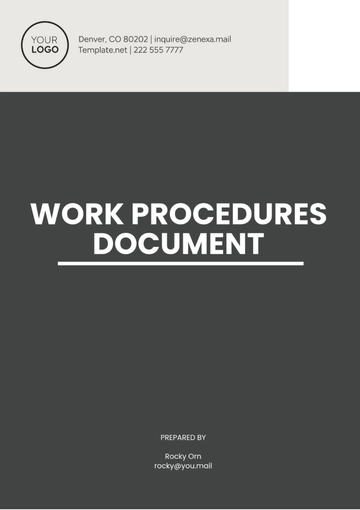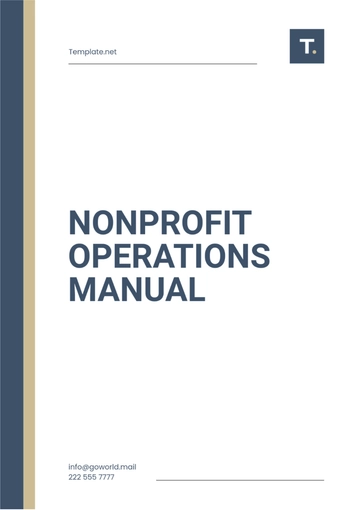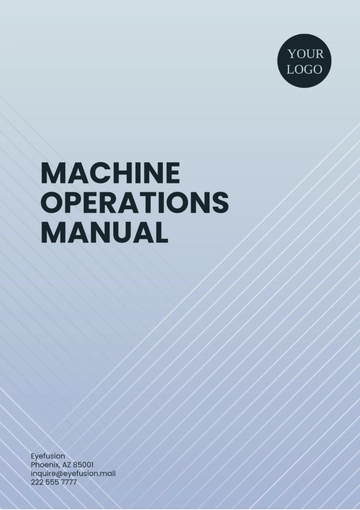Free Administration Budget Manual

The Comprehensive Administration Budget Manual serves as a guide for effectively managing finances across various sectors, including education, healthcare, infrastructure, and economic development. This manual outlines budgeting principles, processes, and best practices to ensure optimal resource allocation and financial sustainability.
I. Definition of an Administration Budget
An Administration Budget is a plan that estimates the expenses required for the administrative functions of a business. This includes salaries, depreciation of office equipment, office rent, utilities, and more. Having an accurate budget allows a company to control its costs and improve its financial performance.
Important Components
Components | Descriptions |
|---|---|
Salaries | The amount given to all employees as compensation for the work they perform. |
Depreciation | The reduction in the value of office equipment over time. |
Rent | Money paid for using office space. |
Utilities | Costs associated with services like electricity, water, and internet. |
Miscellaneous | Other costs that don't fit into the aforementioned categories. This could include refreshments, supplies, etc. |
II. Creating the Administration Budget
Creating an Administration Budget requires careful planning and consideration. This section will guide you through steps, which include gathering information, estimating expenses, and preparing the budget document.
Steps in Creating the Administration Budget
Collect past financial records to help estimate future costs.
Identify and define your fixed costs.
Make a list of all potential variable expenses.
Project future expenditures based on your current business growth rate.
Create a document to record all this information, ensuring it's organized and easy to understand.
III. Budgeting Principles
Budgeting principles serve as guiding principles for effective financial management across various sectors. These principles ensure that resources are allocated efficiently, transparently, and sustainably to achieve organizational objectives. By adhering to these principles, organizations can enhance accountability, optimize resource utilization, and foster financial stability.
Budgeting Principle | Description |
|---|---|
Transparency | All budgetary decisions and allocations should be transparent and accessible to stakeholders. |
Efficiency | Resources should be allocated efficiently to maximize impact and minimize waste. |
Flexibility | Budgets should be flexible to adapt to changing needs and priorities. |
Accountability | Clear accountability mechanisms should be in place to track expenditures and outcomes. |
Sustainability | Budgets should support long-term sustainability by balancing immediate needs with future investments. |
IV. Budget Process
Needs Assessment:
Conduct a comprehensive needs assessment to identify the most pressing priorities and challenges within the community or organization.
Engage stakeholders, including community members, government officials, and organizational leaders, to gather input and perspectives on budget priorities.
Prioritize needs based on factors such as urgency, impact, and feasibility, ensuring alignment with strategic goals and mission.
Revenue Forecasting:
Estimate available revenue streams, including government funding, grants, donations, fees, and other sources of income.
Analyze historical revenue data and trends to inform revenue projections for the upcoming budget period.
Consider external factors such as economic conditions, policy changes, and funding opportunities that may impact revenue forecasts.
Budget Formulation:
Develop a budget framework that outlines strategic objectives, budgetary goals, and allocation priorities.
Allocate resources to different programs, departments, and initiatives based on identified needs, revenue projections, and strategic priorities.
Consider input from stakeholders and experts to ensure that budget allocations are informed by diverse perspectives and expertise.
Budget Approval:
Present the proposed budget to relevant decision-making bodies, such as governing boards, councils, or funding agencies, for review and approval.
Provide detailed explanations and justifications for budgetary decisions, highlighting how allocations align with strategic objectives and address identified needs.
Engage in transparent and inclusive decision-making processes to foster trust, collaboration, and accountability among stakeholders.
Budget Implementation:
Implement the approved budget in accordance with established timelines, guidelines, and procedures.
Allocate funds to designated programs, departments, and initiatives, ensuring adherence to budgetary allocations and spending limits.
Monitor budget execution closely to ensure that expenditures align with budgetary priorities and comply with financial regulations and policies.
Budget Evaluation:
Evaluate budget performance regularly to assess the effectiveness of resource allocation and identify opportunities for improvement.
Monitor key performance indicators, financial metrics, and outcome measures to gauge the impact of budgetary decisions on organizational or community goals.
Solicit feedback from stakeholders and conduct post-implementation reviews to identify lessons learned and best practices for future budget cycles.
Budget Adjustment:
Conduct periodic reviews of budget performance and financial conditions to identify variances, risks, and opportunities.
Adjust budget allocations as needed to reallocate resources to high-priority areas, address emerging needs, or respond to unforeseen circumstances.
Communicate changes to stakeholders and ensure transparency and accountability in budget adjustment processes.
Financial Reporting:
Prepare regular financial reports to provide stakeholders with timely and accurate information on budgetary performance, expenditures, and outcomes.
Communicate financial reports in a clear and accessible manner, using visual aids, narratives, and presentations to facilitate understanding and engagement.
Solicit feedback from stakeholders on financial reporting practices and make improvements based on their input and preferences.
By following a systematic and transparent budget process, organizations can effectively allocate resources, achieve strategic objectives, and promote accountability and stewardship of financial resources.
V. Budget Categories
In managing finances across various sectors such as education, healthcare, infrastructure, and economic development, it's crucial to delineate budget categories for effective resource allocation and financial oversight. The following table outlines key budget categories along with brief descriptions of each:
Budget Category | Description |
|---|---|
Personnel | Includes salaries, wages, benefits, and training expenses for staff members across various departments and programs. |
Program Expenses | Covers costs associated with delivering specific programs and services, including supplies, equipment, and services. |
Infrastructure Investments | Funds allocated for infrastructure projects, including construction, maintenance, and upgrades to facilities and utilities. |
Evaluation Activities | Encompasses expenses related to monitoring and evaluating program performance, including data collection and analysis. |
Contingency Fund | Reserve funds set aside for unforeseen expenses or emergencies to ensure financial stability and mitigate risks. |
By categorizing budgetary allocations into these distinct areas, organizations can enhance transparency, accountability, and efficiency in their financial management practices.
VI. Budget Monitoring and Control
Regular Monitoring: Establish a schedule for regular monitoring of budget performance, with predefined intervals such as monthly, quarterly, or annually. This ensures timely detection of any deviations from the budget and allows for prompt corrective action. Designate responsible individuals or teams to oversee budget monitoring activities and ensure accountability.
Variance Analysis: Conduct thorough variance analysis to understand the reasons behind budget deviations. Compare actual expenditures to budgeted amounts for each budget category and program. Identify any significant variances and investigate the underlying causes, such as unexpected expenses, revenue shortfalls, or changes in program needs. Classify variances as either favorable (underspending) or unfavorable (overspending) and prioritize actions accordingly.
Budget Adjustments: Based on the findings of the variance analysis, make necessary budget adjustments to reallocate resources and address identified issues. Prioritize adjustments to align with strategic objectives and maintain overall budgetary balance. Determine whether adjustments can be made within existing budget allocations or if additional approvals are required. Communicate any proposed budget changes to relevant stakeholders and obtain necessary approvals before implementation.
Forecasting and Projections: Utilize forecasting techniques and financial projections to anticipate future budgetary needs and identify potential challenges or opportunities. Consider factors such as inflation rates, economic trends, funding fluctuations, and program growth projections when forecasting budgetary requirements. Develop contingency plans to address potential risks and uncertainties that may impact budget performance, such as revenue shortfalls or unexpected expenses.
Financial Controls: Implement robust financial controls to prevent unauthorized spending, minimize fraud, and ensure compliance with budgetary policies and regulations. Establish clear procedures for approving expenditures, documenting transactions, and reconciling financial records. Segregate duties to prevent conflicts of interest and enhance accountability in budget management processes. Conduct periodic audits and reviews to assess the effectiveness of financial controls and identify areas for improvement.
Communication and Reporting: Foster open communication channels with stakeholders regarding budgetary matters. Provide regular updates on budget performance, including both successes and challenges encountered. Develop clear and concise financial reports that summarize key budget metrics, variances, and action plans. Tailor reports to different audiences, ensuring that relevant information is provided to decision-makers, program managers, and other stakeholders as needed.
Continuous Improvement: Continuously evaluate and refine budget monitoring and control processes to enhance effectiveness and efficiency over time. Solicit feedback from stakeholders and incorporate lessons learned from past experiences into future budgeting practices. Embrace technological solutions and automation tools to streamline budget management tasks and improve data accuracy. Invest in training and professional development opportunities for staff involved in budgeting to build their skills and capabilities.
By implementing robust budget monitoring and control measures, organizations can effectively manage financial resources, mitigate risks, and achieve their strategic objectives in a transparent and accountable manner.
VII. Common Mistakes while Working with Administration Budgets
Whilst it's crucial to prepare and monitor budgets, avoiding common mistakes is equally important. Here we highlight some pitfalls to watch out for:
Overestimating Revenue: One common mistake is overestimating revenue sources, leading to budget deficits and financial instability. It's essential to conduct realistic revenue forecasting based on historical data and current economic conditions.
Underestimating Costs: Failing to accurately estimate costs can result in budget overruns and inadequate funding for essential programs or services. It's crucial to consider all expenses, including personnel, programmatic, and infrastructure costs, when formulating the budget.
Ignoring Contingencies: Neglecting to allocate funds for contingencies can leave organizations vulnerable to unexpected expenses or emergencies. It's prudent to set aside a contingency fund to cover unforeseen costs and mitigate financial risks.
Not Prioritizing Needs: Allocating funds indiscriminately without prioritizing needs can lead to inefficient resource allocation and suboptimal outcomes. It's essential to conduct a needs assessment and prioritize initiatives based on their impact and alignment with strategic objectives.
Lack of Monitoring and Oversight: Failing to monitor budget performance regularly can result in financial mismanagement and missed opportunities for course correction. It's crucial to establish robust monitoring mechanisms and oversight processes to track expenditures, identify variances, and ensure compliance with budgetary constraints.
Inadequate Communication: Poor communication regarding budgetary matters can lead to misunderstandings, confusion, and lack of buy-in from stakeholders. It's essential to communicate budgetary decisions transparently and effectively, soliciting feedback and keeping stakeholders informed throughout the budgeting process.
Underinvesting in Evaluation: Neglecting to allocate resources for program evaluation can hinder organizations' ability to assess effectiveness, identify areas for improvement, and make informed decisions. It's crucial to allocate sufficient funds for evaluation activities to measure outcomes, track progress, and inform future budgeting decisions.
Failing to Adapt to Changing Needs: Rigid budgeting practices that fail to adapt to changing needs and priorities can limit organizations' ability to respond effectively to evolving circumstances. It's essential to maintain flexibility in budgeting processes and be prepared to adjust allocations as needed to address emerging challenges and opportunities.
VIII. Conclusion
Effective budget management is essential for ensuring the success and sustainability of comprehensive administration initiatives. By following the principles and processes outlined in this manual, organizations can optimize resource allocation, enhance accountability, and achieve meaningful outcomes in education, healthcare, infrastructure, and economic development.
- 100% Customizable, free editor
- Access 1 Million+ Templates, photo’s & graphics
- Download or share as a template
- Click and replace photos, graphics, text, backgrounds
- Resize, crop, AI write & more
- Access advanced editor
Introducing Template.net's comprehensive Administration Budget Manual Template – your ultimate solution for efficient financial management. Editable and customizable, it empowers you to tailor budgeting processes to your organization's needs. Accessible via our AI Editor Tool, streamline budget creation, monitoring, and control effortlessly. Revolutionize your administration today!





























